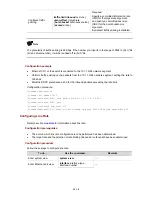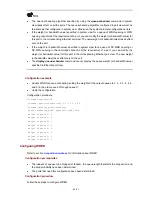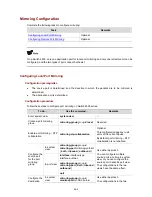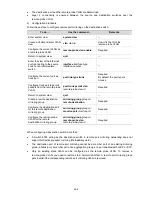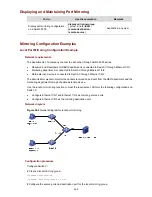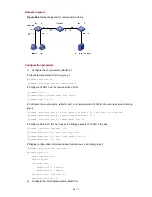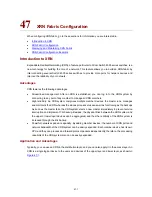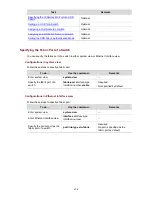
Intermediate
switch
Trunk port
Sends mirrored packets to the destination switch.
Two trunk ports are necessary for the intermediate
switch to connect the devices at the source switch
side and the destination switch side.
Trunk port
Receives remote mirrored packets.
Destination switch
Destination port
Receives packets forwarded from the trunk port and
transmits the packets to the data detection device.
z
Do not configure a default VLAN, a management VLAN, or a dynamic VLAN as the remote-probe
VLAN.
z
Configure all ports connecting the devices in the remote-probe VLAN as trunk ports, and ensure
the Layer 2 connectivity from the source switch to the destination switch over the remote-probe
VLAN.
z
Do not configure a Layer 3 interface for the remote-probe VLAN, run other protocol packets, or
carry other service packets on the remote-prove VLAN and do not use the remote-prove VLAN as
the voice VLAN and protocol VLAN; otherwise, remote port mirroring may be affected.
Traffic Mirroring
Traffic mirroring uses ACL to monitor traffic that matches certain criteria on a specific port. Unlike port
mirroring where all inbound/outbound traffic passing through a port is monitored, traffic mirroring
provides a finer monitoring granularity. For detailed configuration about traffic mirroring, refer to
QoS-QoS Profile Operation
.
Port Mirroring – STP Collaboration
In a LAN, STP or MSTP is usually used to eliminate loops. Configurations or network topology changes
may cause some ports to transit to Discarding state. A port in Discarding state cannot send or receive
packets except BPDUs. If such a port is configured as a mirroring port, mirroring configuration does not
take effect on the port. However, the mirroring configuration still occupies system resources and may
even cause MAC address table oscillation.
Port mirroring – STP collaboration was introduced to address this problem. This feature monitors the
status of each port in real time. The device determines whether to enable port mirroring on a port
according to the status of the port:
z
The device automatically disables port mirroring on a port in Discarding state;
z
The device enables port mirroring on the port when the port restores to Forwarding state.
In this way, port mirroring collaborates with STP, and port mirroring is utilized more efficiently.
For introduction to STP port state, refer to
MSTP Configuration
.
46-3


